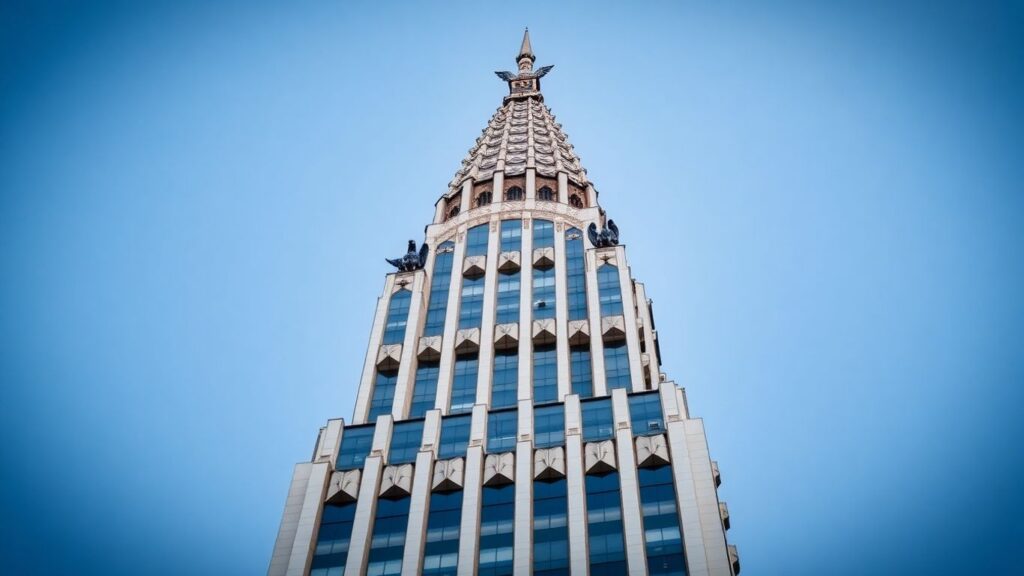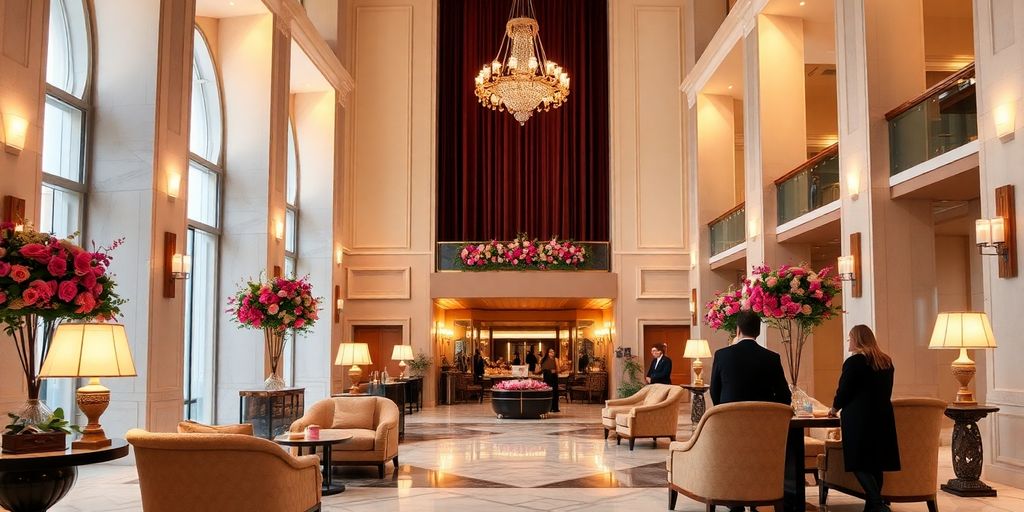What is the architectural style of chrysler building

Ever wondered what makes the Chrysler Building so distinctive? It’s a question many people ask when they see its amazing spire reaching for the sky. The answer, put simply, is its architectural style. This building isn’t just tall; it’s a landmark that tells a story through its design. Let’s break down what is the architectural style of Chrysler Building and why it still captures our attention today.
Key Takeaways
-
The Chrysler Building is a prime example of the Art Deco architectural style, known for its bold geometric shapes and rich ornamentation.
-
Automotive inspirations, like radiator cap motifs and wheel designs, are woven into the building’s exterior and interior, reflecting its namesake.
-
The extensive use of stainless steel, particularly Nirosta, was groundbreaking for its time and contributes significantly to the building’s iconic look and durability.
-
While initially met with mixed reviews, the Chrysler Building’s unique design and luxurious Art Deco interiors have earned it widespread acclaim and recognition as a symbol of New York City.
-
The building’s legacy extends beyond its architectural merit, making it an icon of the stainless steel industry and a lasting emblem of the Roaring Twenties.
The Defining Characteristics of Art Deco Style
Art Deco really hit its stride in the 1920s and 30s, and the Chrysler Building is a prime example of this style. It’s not just about looking fancy; it’s about a whole new way of thinking about design. Before Art Deco, a lot of American buildings were kind of copying European styles. But this new movement? It was all about being original and modern. Think geometric shapes, shiny surfaces, and a general upward thrust that makes you look towards the sky. It was a real departure from the past, embracing new materials and a bold aesthetic. The Chrysler Building, completed in 1930, became a defining symbol of this architectural era.
William Van Alen’s Vision
Architect William Van Alen was the mastermind behind the Chrysler Building. He really pushed the boundaries with his design, creating something that was both modern and incredibly detailed. It’s often described as “hot jazz in stone and steel,” which I think captures the energy perfectly. Van Alen’s work here is seen as one of the most accomplished examples of the Art Deco style, showcasing a blend of geometric patterns and a flair for the dramatic. It was a time of big construction projects in New York, and Van Alen certainly made his mark.
Automotive Inspirations in Design
One of the most interesting things about the Chrysler Building is how much it ties into Walter Chrysler’s own company. You can see car parts everywhere, if you look closely. Think about the decorative elements on the corners of the 31st floor – those are actually modeled after radiator caps from Chrysler cars. It’s a clever way to incorporate the client’s identity right into the building’s skin. This automotive influence is a key part of what makes the Chrysler Building so unique and so tied to its namesake.
The Use of Stainless Steel
Stainless steel was a big deal in the Art Deco period, and the Chrysler Building really shows it off. It’s not just used for structural bits; it’s a major decorative element. The shiny, reflective quality of the steel adds to that modern, glamorous feel. It was a material that spoke of progress and the future, and Van Alen used it to great effect, especially in the building’s iconic crown. This material choice helped make the building a standout, an icon of the burgeoning stainless steel industry at the time. You can see this material used in the entrance doors and other details throughout the structure, contributing to its overall gleam. The building is a testament to the possibilities of new materials.
Art Deco buildings often featured vertical designs that drew the eye upward, incorporating decorative metalwork and glass with geometric and floral motifs. High-shine surfaces and unique sculptural adornments were also common, moving away from historical references towards a more original aesthetic.
Ornamentation and Symbolism
When you look at the Chrysler Building, it’s not just a tall structure; it’s covered in details that tell a story. Architect William Van Alen really went all out, making sure the building reflected the era’s fascination with speed, industry, and luxury. Many of these decorative elements are directly inspired by Chrysler automobiles, which makes perfect sense given who the building was for.
Radiator Cap Motifs
One of the most striking nods to the automotive world appears on the corners of the 31st floor. Here, you’ll find ornaments that look uncannily like the hood ornaments, or radiator caps, from Chrysler’s 1929 models. It’s a clever way to brand the building and celebrate the innovation of the time. These aren’t just random decorations; they’re specific references to the Plymouth car line, adding a layer of brand identity to the skyscraper’s facade.
Eagle Gargoyles
As you look higher up the building, especially around the 61st floor, you’ll notice magnificent eagle heads adorning the structure. These aren’t your typical medieval gargoyles meant to ward off evil spirits. Instead, they symbolize flight and the spirit of the machine age. They’re powerful, dynamic figures that seem to soar, embodying the ambition and forward-thinking attitude of the Roaring Twenties. They really capture that sense of aspiration and progress.
Wheel Motifs and Geometric Patterns
The Chrysler Building is a masterclass in geometric patterns, a hallmark of Art Deco. You can see these repeating shapes and lines everywhere, from the sunburst patterns on the crown to the intricate designs within the elevator cabs. Even the building’s setbacks, dictated by New York’s zoning laws, were turned into opportunities for varied decorative ledges. These geometric elements, combined with the automotive inspirations, create a unified and visually stunning aesthetic that feels both modern and timeless. It’s like the whole building is a giant, intricate piece of jewelry.
The building’s design is a fascinating blend of industrial might and artistic flair. Van Alen didn’t just build a skyscraper; he created a monument to American ingenuity, using decorative elements to celebrate both the Chrysler Corporation and the spirit of the age.
Interior Art Deco Splendor
Stepping inside the Chrysler Building is like stepping back into a more glamorous era. The lobby, in particular, is a masterclass in Art Deco design, a far cry from the sterile, modern spaces you often find today. It’s a place that truly makes you feel something.
The Grand Lobby
The lobby itself is a triangular space, designed to welcome visitors from its multiple street entrances. It’s not just a passageway; it’s an experience. The walls are clad in massive slabs of red African granite, giving the space a rich, almost moody feel. This is complemented by floors made of yellow travertine, with darker bands that guide your eye and your feet towards the elevators. It’s a deliberate design choice, making the space feel both grand and intimate.
Luxurious Finishes and Materials
Walter Chrysler really wanted to impress, and he spared no expense. The building uses materials imported from all over, regardless of cost. You’ll see Nirosta steel used for doors and decorative elements, adding a sleek, metallic sheen. The lighting is also a key feature, with vertical bars of fluorescent light softened by Belgian blue marble and Mexican amber onyx. These materials aren’t just functional; they’re part of the aesthetic, creating a warm, diffused glow that highlights the architectural details. It’s a testament to the era’s appreciation for fine craftsmanship and exotic materials, much like the attention to detail found in a premier Paris hotel.
Ceiling Murals and Wall Cladding
Dominating the lobby is the magnificent ceiling mural, “Transport and Human Endeavor,” by Edward Trumbull. This expansive artwork, painted in warm ochre and gold tones, celebrates the Machine Age and the Golden Age of Aviation. It’s a dynamic piece, filled with geometric patterns, sharp angles, and depictions of planes and industrial might. The mural’s style perfectly embodies the Art Deco spirit. The walls, beyond the granite, also feature special panels. One is dedicated to the workers who built the tower, with figures modeled after the actual tradespeople involved in its construction. It’s a thoughtful touch that honors the human effort behind this architectural marvel.
Public and Critical Reception

When the Chrysler Building first shot up into the New York skyline, people weren’t exactly sure what to make of it. Some folks thought it was a bit much, a real stunt design meant to grab your attention. Critics like Lewis Mumford, who was really into the whole International Style thing back then, weren’t fans. He called it “inane romanticism” and “meaningless voluptuousness.” Others compared it to a giant swordfish or something out of a comic strip. It wasn’t universally loved right out of the gate.
Initial Mixed Reviews
Journalists and the public alike had pretty divided opinions. George S. Chappell famously said it was a design “evolved to make the man in the street look up.” That’s a pretty blunt way of saying it was designed to be a spectacle. Douglas Haskell felt it lacked a solid, unifying idea, suggesting the architect, William Van Alen, might have prioritized flashy effects over substance. Even the general public seemed split, with some seeing it as a “freak” and others as a clever “stunt.” It was definitely a building that sparked conversation, not always the kind you’d find in a polite tea party.
Evolution to Acclaim
But you know how things change? Over time, the Chrysler Building really grew on people. What was once seen as maybe too theatrical or over-the-top started to be appreciated for its unique flair. Later critics, like Robert A. M. Stern, recognized it as a prime example of the stylistic experimentation happening in the 1920s and 30s. Architect Le Corbusier even called it “hot jazz in stone and steel,” which is a pretty cool way to put it. People started to see the building’s energy and its role as a symbol of its time. It wasn’t just a building anymore; it was becoming a piece of art.
A Symbol of New York
Eventually, the Chrysler Building cemented its place as a beloved icon. It came to represent the Roaring Twenties, that era of big dreams and even bigger buildings, right before the stock market crash of 1929. It’s seen as a symbol of that specific kind of optimistic, almost exuberant, spirit. The Landmarks Preservation Commission even said it “embodies the romantic essence of the New York City skyscraper.” It’s more than just steel and glass; it’s a piece of history and a testament to a particular moment in time, much like how geography shapes global politics.
|
Reception Aspect |
Initial View |
|---|---|
|
Design |
Stunt, theatrical, lacking organic idea |
|
Public Opinion |
Mixed: freak vs. stunt |
|
Later Critical View |
Stylistic experimentation, energetic, iconic |
The Chrysler Building’s Legacy

Even though its reign as the world’s tallest building was pretty brief – just about 11 months – the Chrysler Building has left a massive mark on the architectural world and New York City itself. It’s more than just a tall building; it’s become a symbol, a real icon.
An Icon of the Stainless Steel Industry
The Chrysler Building really showed off what stainless steel could do. Before this, steel was mostly hidden away, but here, it was used for decoration, especially on that amazing crown. It proved that steel wasn’t just for structure, but could be beautiful too. This really pushed the boundaries for how architects thought about using materials.
Influence on Global Architecture
That distinctive Art Deco look, with its sharp lines and those amazing eagle gargoyles, has inspired buildings all over the planet. You can see echoes of it in places like Chicago and even Dubai. It’s like the Chrysler Building set a standard for what a modern skyscraper could look like, blending style with height in a way that just clicked with people.
A Lasting Emblem of the Roaring Twenties
This building just screams the Roaring Twenties. It captures that era’s energy, optimism, and a bit of its flashiness. It was built during a time of big dreams and rapid change, and it stands as a testament to that spirit.
The Chrysler Building is often cited as one of the most beloved skyscrapers in New York, a testament to its enduring design and cultural significance.
Here’s a quick look at how it stacks up:
-
Height: 1,046 feet (319 meters)
-
Floors: 77
-
Construction Completed: 1930
-
Architectural Style: Art Deco
It’s funny, when it first opened, not everyone was a fan. Some folks thought it was a bit much. But over time, people really came around. Now, it’s hard to imagine the New York skyline without it. It’s not just a building; it’s a piece of history that keeps on inspiring.
The Enduring Appeal of the Chrysler Building
So, when you look up at the Chrysler Building today, you’re not just seeing a tall structure. You’re seeing a piece of history, a bold statement from a time when New York was really finding its stride. It’s a building that people either loved or found a bit much at first, but it definitely made them look. Over time, though, it’s become this beloved icon, a symbol of what Art Deco could do. It’s more than just steel and glass; it’s a reminder of a unique design spirit that still captures our imagination, proving that some buildings just have that lasting wow factor.
Frequently Asked Questions
What is the main architectural style of the Chrysler Building?
The Chrysler Building is a prime example of the Art Deco architectural style. This style was popular in the 1920s and 1930s and is known for its geometric shapes, rich ornamentation, and use of modern materials.
Who designed the Chrysler Building?
The building was designed by William Van Alen, a talented architect who aimed to create a unique and eye-catching skyscraper. It was commissioned by Walter Chrysler, the founder of the Chrysler Corporation.
What are some of the unique design features of the Chrysler Building?
The building is famous for its distinctive stainless steel crown, which resembles a series of arches. It also features decorative elements inspired by automobiles, like radiator cap motifs and eagle gargoyles that look like car hood ornaments.
Why is stainless steel so important to the Chrysler Building’s design?
Stainless steel was a relatively new material when the building was constructed. Its shiny, bright surface was perfect for Art Deco’s emphasis on modernism and upward movement. The Chrysler Building was one of the first major buildings to use it so extensively on its exterior, making it an icon of the stainless steel industry.
How was the Chrysler Building received when it was first built?
When it first opened, people had mixed feelings. Some thought it was too flashy or unusual, while others immediately loved its bold and modern look. Over time, it became widely admired and is now seen as a masterpiece.
Is the Chrysler Building still considered important today?
Absolutely! The Chrysler Building is celebrated as a symbol of New York City and a masterpiece of Art Deco architecture. It’s admired for its beauty, its innovative design, and its lasting impact on architecture around the world.








Responses